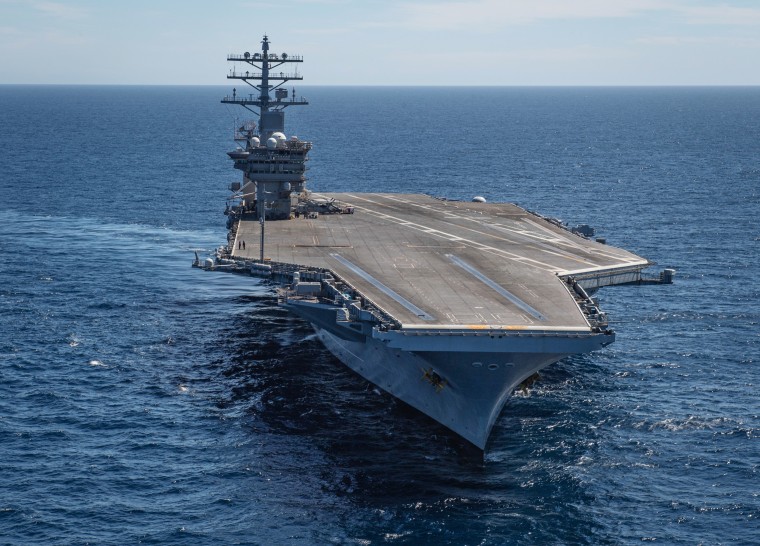Thousands of crew members aboard the USS Nimitz are back at sea about two weeks after officials determined military jet fuel seeped into the ship’s water supply, sparking concerns by some that the contamination has not been fully contained.
At least 11 sailors reported having rashes, diarrhea and other symptoms that could be linked to ingesting fuel after "trace amounts" of jet propellant-5 were discovered in one of the ship’s potable water tanks on Sept. 16, the Navy said.
The Navy's latest tally of sick sailors grew from five over the weekend. But the contamination may have poisoned more people, for longer than a couple of weeks, current and former USS Nimitz sailors said.
One sailor, who asked to remain anonymous out of fear of retaliation, said there were at least three instances this May through July when he and his colleagues could smell the strong and “obvious” scent of fuel in the drinking water.
“I smelled it, and I was like, I’m not drinking that,” he said.
The ship’s leaders were aware of the potent scents, which would come and go back then, he said.
Another sailor, who did recently drink the water, developed a rash and a persistent dry cough on Sept. 22, but has not received medical treatment, the sailor’s parents said. That sailor is relying on a self-purchased case of 24 water bottles, the parents said.
“The way they’re treating these sailors, it’s absolutely obscene,” said the sailor’s mother, who asked to remain anonymous out of fear of retaliation for her child.
Since Sept. 17, the USS Nimitz had been docked in San Diego, where the ship's water system underwent testing and flushing while connected to the city's water supply.
It left the port Sunday morning in preparation for an upcoming deployment after “all tests came back in limits and the potable water was determined to be safe for the crew,” Cmdr. Sean Robertson, a spokesperson for the U.S. 3rd Fleet, said in a statement.
Robertson said that the ship’s water system was flushed with roughly 1 million gallons of fresh water and that a state-certified laboratory tested the water 70 times since Sept. 21.
The 11 sailors who reported having headaches, rashes and diarrhea presented symptoms between Sept. 17 and Sept. 26. They have all been treated and cleared for duty, Robertson said.
It is still unclear how much fuel was discovered and exactly how the fuel entered one of the carrier’s 26 potable water tanks. On Tuesday, the Navy said it was investigating what caused the contamination.
The impacted tank, and three others near it, as a precaution, have been isolated, power-washed and scrubbed from the inside, U.S. 3rd Fleet spokesperson Lt. Samuel Boyle said.
But without knowing the root cause, sailors and their families say the Navy cannot know for sure that the issue has been resolved, and they worry the water may still be dangerous for the 5,000 crew members on board to drink or use for bathing.
"They’re rushing to do this at the detriment of the sailors," said the mother of the sailor with the untreated rash and dry cough.
This is not the first time military jet fuel has seeped into drinking water. Some 6,000 people said they were poisoned by drinking water that was contaminated by leaks from the Red Hill bulk fuel storage facility, near Pearl Harbor, last year.
Four ailing military families, formerly based in Hawaii, filed a federal lawsuit against the U.S. government last month.
Federal and state health officials are still trying to study the effects of such a widespread leak, which Dr. Diana Felton, a toxicologist with the Hawaii Department of Health, called “unprecedented.”
Hawaii’s Health Department and the U.S. Centers for Disease Control and Prevention conducted an initial survey this year of more than 2,200 people affected by that leak.
The most commonly reported symptoms of jet fuel contamination were headache, fatigue, diarrhea, nausea, dry or itchy skin, anxiety, skin rash, irritation of the eyes, dizziness and lightheadedness, the joint study found.
Other participants said they had difficulty concentrating, and many reported that symptoms lasted longer than a month.
The CDC said many factors determine whether a person exposed to jet propellant-5 will be harmed. That includes the duration and dose of the exposure, and how the person was exposed — whether from inhalation, ingestion or contact with skin.
The agency said exposure could cause damage to the liver, decreased immune response, impaired hearing and impaired performance on neurological function tests.
The USS Nimitz, the oldest aircraft carrier in active Navy service, is nearing its decommission after 50 years, the Navy said in 2018.
The unknown has left crew members' loved ones on edge.
“We were worried about them even before they shipped out,” the mother said. “And now that they’re completely dependent on that water system, it’s 1,000 times more worrisome.”

